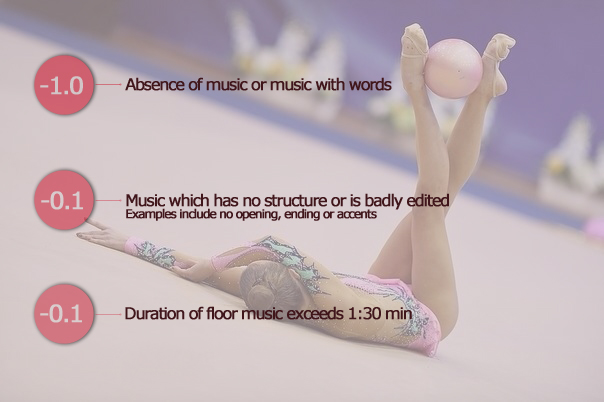-
Share this post
Gymnastics Floor Music – 3 Important Things Everyone Should Know
Let’s face it – reading the FIG Code of Points can be a tedious exercise. However bear in mind that along with providing useful technical information, it plays a major role in guiding coaches and gymnasts in composition of the floor exercise. In this article we are going to focus specifically on the important role of floor music and artistry in gymnastics floor routine.
When creating a new gymnastics floor routine, you need to remember that the main objective is to present a unique and well-balanced artistic composition which combines the body movements and expression of the gymnast harmoniously with the theme and character of the music.
Music
The music must be flawless, without any abrupt cuts, and must contribute a sense of unity to the overall composition and performance of the exercise. It should flow and must have a clear start and clear finish. The chosen floor music must also help to highlight the unique characteristics and style of the gymnast. The character of the music should provide the guiding theme of the composition.
Musicality is the ability of the gymnast to interpret the music and to demonstrate not only its rhythm and speed, but its flow, shape, intensity and passion. The music must support the performance and through her movements, the gymnast, must convey the theme of the music to the audience and jury.
You won’t be wrong in thinking that some of these things are hard to capture which in turn can give rise to the judicial subjectivity, although there are specific rules that govern all of the above.
Music Timing
The evaluation of the exercise begins with the first movement of the gymnast. The duration of the floor exercise may not exceed 1:30min (90 seconds).
- The assistant begins timing when the gymnast begins with the first movement of her floor exercise.
- The assistant stops timing when the gymnast ends her floor exercise with the last position. The exercise must end with the music.
- Elements performed after this time limit will be recognized by the Difficulty Panel and evaluated by the Execution Panel.
CD Requirements
The floor exercise music CD must be given to the competition administration. Each CD is to be timed and the said time will have to be approved by the administration and the delegation head coach.
Remember that the following must be written on the CD:
- The name of the gymnast and the 3 capitalized letters used by FIG for the country code.
- The name of the composer and of the title of the music.
The musical accompaniment with orchestration, piano or other instruments must be recorded.
A signal or tone may be used at the beginning of the recording. However, the name of the gymnast may not be spoken. Did you know that TuneGym can edit a different signal for you gymnastics floor music?
The human voice may be used as a musical instrument without word/s. Examples of the ‘human voice’ as an acceptable instrument are: humming, vocalizing without words, whistling, chanting.
One of the main goals of this article is to dispel a common belief that human voices are prohibited in the floor music. Most coaches and gymnasts try to avoid many floor songs that have humming in them despite the fact that they like the music and which according to official regulations would not trigger any deductions.
Source: FIG 2013-2016 WAG CODE OF POINTS (www.fig-gymnastics.com/publicdir/rules/files/wag/WAG%20CoP%202013-2016%20(English)%20Nov%202014.pdf)

